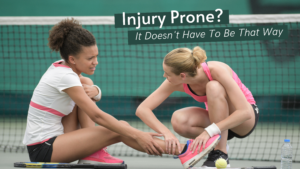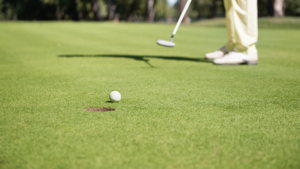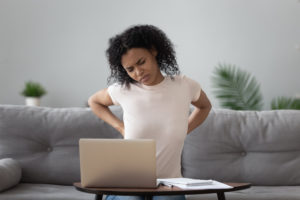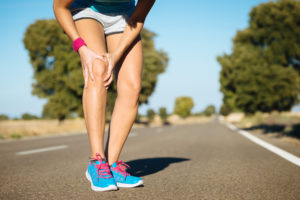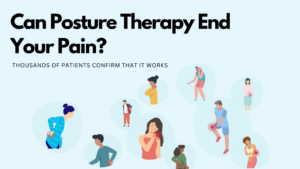
New Therapy Method Can End Your Chronic Pain
Millions of us wake up each day with muscle, joint or back pain. From loosing your job to giving up your favorite activities, chronic pain can put a real damper on your quality of life. Sadly, traditional treatments, medications, and surgeries have not yet solved the pain epidemic afflicting so many. Fortunately, there is a new player in the pain-relief game. Posture Therapy is a promising new alternative for its low-risk, simple methodology that has been proven effective for a wide range of pain conditions. Posture Therapy really isn’t all that new. It has been around for over 40 years. It’s receiving new attention however, as thousands of testimonials(1) from patients of trained Posture Therapists and a recent clinical study provide evidence that Posture Therapy is worth a try. The Journal of the American Medical Association published a randomized clinical trial performed from 2017 to 2020 which determined Posture Therapy is “as good or better at treating spine pain than usual medical care.”(2) There’s even a book written about patients whose lives were changed by posture therapy. Many are patients who had not found relief anywhere else.(3) Not only does Posture Therapy provide better pain relief for all kinds of muscle and joint conditions, it is also risk-free compared to prescription meds and invasive surgeries. What is Posture Therapy? Posture therapy is the correction of posture to relieve muscle and joint pain. Each patient’s posture is analyzed in comparison to the ideal human posture. Special exercises which are specially sequenced for optimal results are prescribed to restore proper joint angles and muscle strength. A few key principles make posture therapy different from many other exercise or pain relief therapies that may have failed you. Posture Therapy Differences: Whole-body Treatment Focus Specific, Unique-to-each-patient Therapy Plans Simple, Easy To Perform Movements Focus on Posture Improvement 1. Whole Body Focus Posture Therapy is one of the only pain relief therapies to assess and correct imbalances from head to toe, no matter where your symptoms present themselves. Pain and symptoms in one area are often caused by something that is happening in another area. With a whole-body therapy plan, the root cause of the pain will be identified and addressed more quickly, so you won’t waste time chasing symptoms. 2. Unique-To-You Therapy Plan The Posture Therapy routines prescribed are never the same for any two people. Every session begins with a complete assessment of your pain history and a head- to-toe posture analysis. Photos and a gait analysis are used to assess your current posture and movement limitations. A series of exercises are then carefully assigned to each patient to bring the crooked parts of your posture back to square. Your past injuries, activity levels, jobs, sports, and more contribute to how your body looks at this very moment. Your body looks and moves differently from everyone else’s, so your therapy should also be specific to you too. 3. Simple, Easy To Perform Exercises Posture therapy exercises are specialized, but are simple enough to be performed at home by anyone. Many of the exercises use body weight and are performed against a level surface for frame of reference, like a wall, chair, or the floor. This is how the exercise positions themselves effectively square up your joints with no special equipment. When the muscles regain their proper length and tension, right to left and front to back, the pressure, stress, and pain from uneven joints and pinched nerves is relieved. Sound simple? It really is. 4. Focus On Posture Improvement The goal of every exercise used in a Posture Therapy routine is to straighten your load bearing joints, and return function to your entire muscular system. The exercises may look and feel similar to those in yoga, pilates, and other movement therapies. However, slight variations to these common exercises have a more pronounced effect on deep posture muscles. Performing a downward dog or squat with your feet turned out will activate different muscles than if your feet are pointed straight ahead. A Posture Therapist is an expert on the change that each variation of an exercise will elicit, and they will assign the version that is right for your body. Once the right exercises are selected, they are sequenced in a way for your body to regain function in the fastest way possible. With this combination, you’ll get your crooked posture back to straight again in no time. Your body responds to the stimulus you give it, you just need the right exercises in the right order to get you moving again pain-free. Posture Therapy begins with a complete, whole-body assessment that may involve photos, gait analysis, and functional tests. From the assessment, your therapist will assign a series of gentle exercises and movements specifically for your body. With the muscles functioning more properly in a balanced postural position, your body will move freely again, pain-free. Posture Therapy is risk-free, simple to do, and effective for relieving pain. Where can you find Posture Therapy? Start online at PTXTherapy.com or find a clinic near you. 1 Posture Solutions.com Testimonials Painfree Posture Clinic Testimonials Posture First Testimonials Align Pain Solutions Testimonials PTX Therapy Life Stories Exercise Therapy KC Testimonials Verticalign Testimonials Pain Free Denver Testimonials 2 Choudhry NK, Fifer S, Fontanet CP, et al. Effect of a biopsychosocial intervention or postural therapy on disability and health care spending among patients with acute and subacute spine pain: The SPINE CARE randomized clinical trial. JAMA. 2022;328(23):2334-2344. doi:10.1001/jama.2022.22625 3 Greenfield, E., & Ferrante, M. (2019). How Did I Not Know About This?: Becoming Pain-free Through Posture Therapy. North Atlantic Books.

